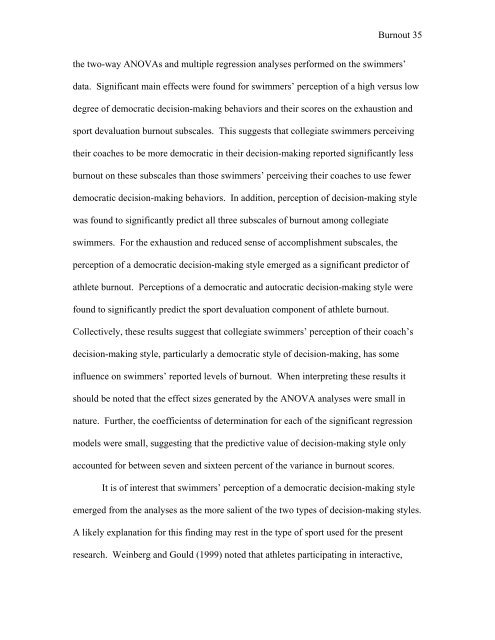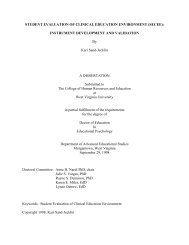Coach and Athlete Burnout - West Virginia University
Coach and Athlete Burnout - West Virginia University
Coach and Athlete Burnout - West Virginia University
You also want an ePaper? Increase the reach of your titles
YUMPU automatically turns print PDFs into web optimized ePapers that Google loves.
<strong>Burnout</strong> 35<br />
the two-way ANOVAs <strong>and</strong> multiple regression analyses performed on the swimmers’<br />
data. Significant main effects were found for swimmers’ perception of a high versus low<br />
degree of democratic decision-making behaviors <strong>and</strong> their scores on the exhaustion <strong>and</strong><br />
sport devaluation burnout subscales. This suggests that collegiate swimmers perceiving<br />
their coaches to be more democratic in their decision-making reported significantly less<br />
burnout on these subscales than those swimmers’ perceiving their coaches to use fewer<br />
democratic decision-making behaviors. In addition, perception of decision-making style<br />
was found to significantly predict all three subscales of burnout among collegiate<br />
swimmers. For the exhaustion <strong>and</strong> reduced sense of accomplishment subscales, the<br />
perception of a democratic decision-making style emerged as a significant predictor of<br />
athlete burnout. Perceptions of a democratic <strong>and</strong> autocratic decision-making style were<br />
found to significantly predict the sport devaluation component of athlete burnout.<br />
Collectively, these results suggest that collegiate swimmers’ perception of their coach’s<br />
decision-making style, particularly a democratic style of decision-making, has some<br />
influence on swimmers’ reported levels of burnout. When interpreting these results it<br />
should be noted that the effect sizes generated by the ANOVA analyses were small in<br />
nature. Further, the coefficientss of determination for each of the significant regression<br />
models were small, suggesting that the predictive value of decision-making style only<br />
accounted for between seven <strong>and</strong> sixteen percent of the variance in burnout scores.<br />
It is of interest that swimmers’ perception of a democratic decision-making style<br />
emerged from the analyses as the more salient of the two types of decision-making styles.<br />
A likely explanation for this finding may rest in the type of sport used for the present<br />
research. Weinberg <strong>and</strong> Gould (1999) noted that athletes participating in interactive,












